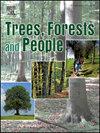尼泊尔乌达亚普尔县 Shorea robusta (Garten. f.) 森林中 Phoenix acaulis (Roxb.) 管理对生态的影响和社区的看法
IF 2.7
Q1 FORESTRY
引用次数: 0
摘要
Phoenix acaulis(Roxb.)是尼泊尔丘雷地区常见的林下灌木,但到目前为止,对它的研究仍然很少。因此,本研究旨在考察乌达亚普尔地区凤凰木对 Shorea robusta (Gaertn. f.) 森林特性的生态影响,并探讨相关社区对尼泊尔乌达亚普尔地区 S. robusta 森林的看法。本研究采用了分层随机抽样法,将乌头椿密度(高、低和无)作为分层的依据。共建立了 45 个面积为 10 米 x 10 米的矩形地块(每类 15 个),用于再生调查和土壤样本采集(30 厘米以下)。土壤质量指数(SQI)法是在尼泊尔先前研究的基础上,使用指标对土壤质量进行评估。采用随机抽样的方法,对社区森林使用者群体中的 52 个家庭进行了访谈,以收集他们对 P. acaulis 及其管理所产生的影响的看法。在无金针虫地区观察到的 S. robusta 幼苗和树苗密度最高(1132 ± 9.65 ha-¹ 和 60 ± 0.63 ha-¹),而在金针虫密集地区观察到的 S. robusta 幼苗和树苗密度最低(548 ± 7.4 ha-¹ 和 4 ± 0.2 ha-¹)。同样,高密度地区的 SQI 较高(0.49),其次是低密度地区(0.45)和无密度地区(0.39)。大多数受访者主张从森林中移除 P. acaulis,这凸显了利益相关者的重大关切。我们的研究表明 P. acaulis 对土壤质量有积极影响,但对 S. robusta 的再生有消极影响。因此,建议进一步研究探索管理策略,以平衡对土壤质量的积极影响和观察到的对 P. acaulis 存在区域再生的消极影响。本文章由计算机程序翻译,如有差异,请以英文原文为准。
Ecological impact and community perception of Phoenix acaulis (Roxb.) management in Shorea robusta (Garten. f.) forest of Udayapur district, Nepal
Phoenix acaulis (Roxb.), a common understory shrub in Nepal's Chure region, has remained largely understudied until now. Therefore, this study aims to examine the ecological impact of P. acaulis on Shorea robusta (Gaertn. f.) forest properties and to explore associated community perceptions in S. robusta forest of Udayapur district, Nepal. Stratified random sampling was adopted for this study where P. acaulis density (high, low and absent) was considered as basis of stratification. Altogether, 45 rectangular plots of 10 m x 10 m area (15 each category) were established for regeneration survey and soil sample collection (up to 30 cm). Soil quality index (SQI) method was used for soil quality assessment using indicators on the basis of prior studies conducted in Nepal. Using random sampling, a total of 52 households from the community forest user group were interviewed to gather their insights on the perceived effects of P. acaulis and its management. Highest S. robusta seedling and sapling density was observed in P. acaulis absent area (1132 ± 9.65 ha⁻¹ and 60 ± 0.63 ha⁻¹) where lowest in P. acaulis dense area (548 ± 7.4 ha⁻¹ and 4 ± 0.2 ha⁻¹). Similarly, higher SQI was in areas with high P. acaulis density (0.49) followed by low (0.45) and absent area (0.39). Most respondents advocated for removing P. acaulis from the forest, highlighting significant concerns among stakeholders. Our study suggests a positive impact P. acaulis on soil quality but indicates a negative impact on S. robusta regeneration. Therefore, further research to explore management strategies that balance the positive impact on soil quality with the observed negative influence on regeneration in P. acaulis presence areas is recommended.
求助全文
通过发布文献求助,成功后即可免费获取论文全文。
去求助
来源期刊

Trees, Forests and People
Economics, Econometrics and Finance-Economics, Econometrics and Finance (miscellaneous)
CiteScore
4.30
自引率
7.40%
发文量
172
审稿时长
56 days
 求助内容:
求助内容: 应助结果提醒方式:
应助结果提醒方式:


